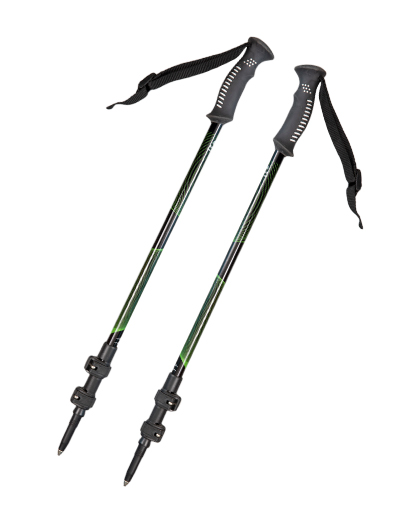

Some people call the trekking pole "the other pair of feet." Many people disdain trekking poles: I am so young, I don't need a walking stick! Or to say: I don't climb mountains, I use it, and it ’s not objective and irresponsible to make a negative evaluation of something I haven't used. What should I pay attention to when using trekking poles? Walking on the mountain road, when there is a cliff on one side. Be sure to use the trekking pole on the side of the mountain, otherwise it is easy to be dangerous! Usually develop the habit of using a cane with both left and right hands; try not to insert the trekking pole into seawater and water with high calcium content. Otherwise it will corrode the cane or be difficult to clean up; the trekking pole is not a devil's pestle or a diamond rod. Be gentle with it. Anyone who uses the cane violently will break it, and it may be dangerous. Do you know how to use the trekking pole?

1. Adjust the length of the trekking pole. Generally, there are two sections of the three-section trekking pole that can be adjusted. At first, all the trekking poles are unscrewed. Extend the pole near the bottom to the maximum limit length, there are scales on the trekking pole for reference. Hold the trekking pole on a flat surface and adjust the length of the trekking pole. The arm naturally hangs down, with the elbow as the fulcrum, raise the forearm to 90 degrees with the upper arm, and then adjust the tip of the trekking pole to contact the ground Place your head under your armpit for 5-8 cm, then adjust the tip of the pole down until it touches the ground, and lock all the poles of the trekking pole. Another hiking stick that has not yet been adjusted can be adjusted to the same length as that of the locking length. When adjusting the trekking pole, it should not exceed the maximum adjustment length shown on the trekking pole. When purchasing the trekking pole, you can first make a length adjustment to determine whether you can buy a trekking pole of suitable length.
2. Use of wrist strap. Most people use the trekking pole to hold the trekking pole tightly to apply force, thinking that the role of the wrist strap is only to prevent the trekking pole from leaving your wrist. If you think so, then you are wrong. Wrist The importance of the belt is no less than the strength of the trekking pole itself. When we use the trekking pole downhill, the impact of the trekking pole should be transmitted to our arm through the wrist strap. When going uphill, the thrust of the arm is transferred to the trekking pole through the wrist strap to generate the uphill boost. Therefore, when our wrist passes through the wrist strap, we should not extend directly from the top of the wrist strap to grasp the handle, but the wrist strap. Take it up, insert it from under the wrist strap, press the strap into our palms, and then gently grasp the handle to support the trekking pole through the wrist strap instead of holding the handle tightly. force. If there is a buckle, make some adjustments, remember not to affect the operation of the trekking pole.
3. Flat ground and gentle uphill. Take the same rhythm as you normally walk. With your right arm in front of your left foot, take the trekking pole forward, but the tip of the pole should not exceed the front of your body, and then push it against the ground, and the left hand interacts with your right hand .
4. Steep steep slope. The movement is the same as normal walking, but the arm should be placed in front of the body in front of the body. Use the trekking pole to support the body upwards to reduce the pressure on the legs. If necessary, you can use two trekking poles to climb at the same time. Action, when pushing the body up, the palm can be placed on the top of the trekking pole to strengthen the pushing force.
5. Downhill. Due to the relatively large downhill impact force, the trekking pole must be used to reduce the load on the legs. Therefore, the position of the trekking pole must be placed in front of the body, and it must be grounded before the forefoot to achieve the effect of sharing power. Therefore, the body must be tilted forward. This action is not a natural action for us to descend. Therefore, we need to practice frequently, and at the same time, we must feel how far the trekking pole should be placed, in order to achieve the effect of reducing leg pressure, and will not drag Slow down the speed and rhythm of the original travel. When necessary, the length of the trekking pole can be lengthened and adjusted completely according to personal feelings.